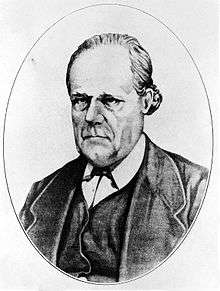Louis-Daniel Beauperthuy

Louis-Daniel Beauperthuy (25 August 1808 – 3 September 1871) was a French physician who made important contributions to the study of the causes of infectious diseases such as yellow fever, malaria, and leprosy.[1][2] He was the first to systematically argue that malaria and yellow fever were transmitted by mosquitos.[3]
Beauperthuy was born in Basse-Terre, Guadeloupe, France. He studied medicine at the Paris Faculty of Medicine, and obtained his M.D. in 1837. He was immediately appointed by the Paris Museum of Natural History as a "Travelling Naturalist" to work in Orinoco, Venezuela. His primary duty was to study the prevalent diseases in the area. He was one of the earliest scientists to observe microorganism using microscopy in relation to diseases. In 1838 he developed a theory that all infectious diseases were due to parasitic infection with "animalcules" (microorganisms). With the help of his friend M. Adele de Rosseville, he presented his theory in a formal presentation before the French Academy of Sciences in Paris. He suspected that mosquitos were the carriers of the infectious pathogens, including those of leprosy. He noted:
The patients should live in as healthy a locality as possible, and not in the neighbourhood of marshes, etc. They are required to sleep under mosquito nets so as to prevent the sting of insects, which irritate and inflame the skin and perhaps propagate the disease.
In 1842 he worked at the Facultad Médica de Caracas (Caracas Medical School). In 1850 he became professor of anatomy at the School of Medicine of the College of Cumana.[4] He was appointed the Director of the Leper Hospital in Demerara in British Guiana, the post he held till his death.[1]
By 1853, he was convinced that malaria and yellow fever were spread by mosquitos. He even identified the particular group of mosquitos that transmit yellow fever as the "domestic species" of "striped-legged mosquito", which can be recognised as Aedes aegypti, the actual vector. He published his theory in 1854 in the Gaceta Oficial de Cumana ("Official Gazette of Cumana"). His reports were assessed by an official commission, which discarded his mosquito theory.[3]
A hospital in Basse-Terre, called the Centre hospitalier Louis-Daniel Beauperthuy,[5] was established in 1959 in his honour.[6]
References
- 1 2 Agramonte, Aristides (1908). "An Account of Dr. Louis-Daniel Beauperthuy". The Boston Medical and Surgical Journal. 158 (25): 927–930. doi:10.1056/NEJM190806181582501.
- ↑ Godoy, G. A; Tarradath, E. (2010). "Short biography of Louis Daniel Beauperthuy (1807-71): pioneer of microbiology and medical science in Venezuela". Journal of Medical Biography. 18 (1): 38–40. doi:10.1258/jmb.2009.009095. PMID 20207900.
- 1 2 Agramonte, A (2001). "The inside history of a great medical discovery. 1915". Military Medicine. 166 (9 Suppl): 68–78. PMID 11569397.
- ↑ Lemoine, Vidal Rodríguez (2007). "Beauperthuy". Revista de la Sociedad Venezolana de Microbiología (in Spanish). 27 (3): 1.
- ↑ "Centre hospitalier Louis-Daniel Beauperthuy (Pointe-Noire)". etablissements.fhf.fr. Fédération Hospitalière de France. Retrieved 14 June 2016.
- ↑ "Le site du CHLDB » Qui sommes nous?". www.chldb.fr. Centre hospitalier Louis-Daniel Beauperthuy. Retrieved 14 June 2016.
Further reading
- Lemoine, Walewska; Suárez, María Matilde (1984). Beauperthuy: de Cumaná a la Academia de Ciencias de París. Fundación para la Ciencia José Gregorio Hernández.
- Beauperthuy, Louis Daniel (1891). Travaux scientifiques de Louis-Daniel Beauperthuy. Bordeaux, France: Imprimerie Nouvelle A. Bellier et Cie.